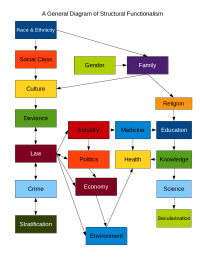Description
Dynamic social impact theory is a concept created by American social psychologist, Bibb Latané in 1981.
It describes as complex systems
Basic Tenets
Dynamic social impact theory suggests that culture is created and shaped by local social influence as people influence and are influenced by others in proportion to their strength, immediacy, and number.[1]
The influence of members between majority and minority groups change and develop over time and four group-level phenomena emerge which can be defined as follows:[2]
Consolidation
As individuals interact with each other regularly, their actions, attitudes, and opinions become more uniform. The opinions held by the majority tend to spread throughout the group, while the minority decreases in size.
Clustering
Occurs when group members communicate more frequently as a consequence of close proximity. As the law of social impact suggests, individuals are susceptible to influence by their closest members, and so clusters of group members with similar opinions emerge in groups. Minority group members are often shielded from majority influence due to clustering. Therefore, subgroups can emerge which may possess similar ideas to one another, but hold different beliefs than the majority population.
Correlation
Over time, individual group members’ opinions on a variety of issues (including issues that have never been openly discussed before) converge, so that their opinions become correlated.
Continuing diversity
As mentioned previously, minority members are often shielded from majority influence due to clustering. Diversity exists if the minority group can resist majority influence and communicate with majority members. However, if the majority is large or minority members are physically isolated from one another, this diversity decreases.
Social Impact Theory (SIT)
According to SIT, social impact is the amount of social influence individuals have on one another and is a multiplicative function of strength (elements that make a person more persuasive or better able to resist persuasion, such as expertise, physical attractiveness, or personality), immediacy, and number. Immediacy is defined as closeness in social space. Social space is constrained by physical space (Latané & Liu, 1996; Nowak, Latané, & Lewenstein, 1994), but not completely equivalent to it. For example, in an apartment building, a person may be more immediate to a downstairs neighbor (Bob), than one who lives beside him (Joe), if the person passes by Bob’s but not Joe’s apartment every day on his way out of the building. Influence declines exponentially as social space increases (Latané et al., 1995). Number is the number of people doing the influencing or being influenced, and is also a power function. Each additional person adds a little less unique influence. You will be more influenced by two people arguing a position than one person, but the 301st person probably will not have much influence beyond the 300th. SIT has been well supported by studies examining a variety of types of influence situations. High strength persuaders, operationalized in terms of status (Williams & Williams, 1983), expertise (Wolf & Latané, 1983), or dress (Jackson & Latané, 1981a; Sedikides & Jackson, 1990; Williams & Williams, 1989) are more influential than lower strength persuaders. Immediacy also has an effect on influence. Zoo visitors comply more readily to requests made by an experimenter who is physically closer to them than to one in another room (Sedikides & Jackson, 1990), and people in the USA and China report more influence from those who live closest to them.Number has received the most empirical attention, likely due to its easy manipulation. The number of people endorsing a particular restaurant choice (Wolf & Latané), donating money to cancer research (Jackson & Latané, 1981a), or choosing one answer over another (Asch, 1955) affect social influence. These factors also seem to combine multiplicatively as the theory suggests (e.g. Jackson & Latané, 1981a, b; Latané & Harkins, 1976; Wolf & Latané).[1:1]
SIT is a static theory, however, predicting influence on one element at a time and from one person or group to another. In reality, of course, influence is reciprocal (you influence me as I influence you) and recursive (we continue to influence one another on a variety of issues over time). Hence…"[1:2]
